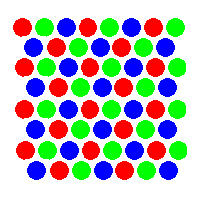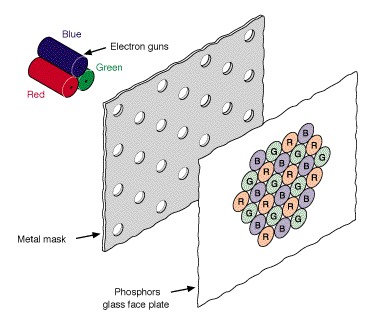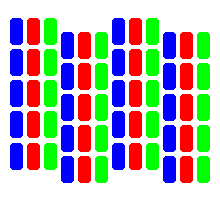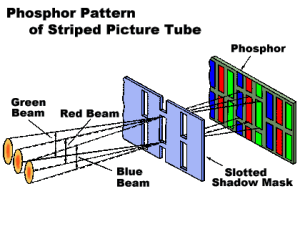Color Video
Delta Electron Gun Arrangement |
Color CRTs are much more complicated
|
|
Color CRT's are more complicated than the simple monochrome
models summarized before. The phosphors on the face of a color CRT are laid
out in a precise geometric pattern. There are two primary variations, the stripe
pattern of in-line tubes shown on the left, and the delta pattern of delta tubes
as shown on the right.
Within the neck of the CRT there are three electron guns, one each for red,
green, and blue (the actual beams are all the same color-- invisible). There
is also a special metal plate just behind the phosphor cover front face, called
a shadow mask. This mask is aligned so that it simultaneously allows each electron
beam to see only the phosphors of its assigned color and blocks the phosphor
of the remaining two colors.
The figure shown above shows the configuration of an example in-line tube. On
page 44 of Hearn & Baker you'll see a similar diagram for a delta electron
gun configuration
A significant portion of the electron beam's energy strikes the mask rather
than the phosphors. This has two side effects. The shadow mask has to be extremely
rigid to stay aligned with the phosphor patterns on the CRT face. The collision
of electrons with metal mask causes the mask to emit some of it absorbed energy
as electromagnetic radiation. Most of this energy is in the form of heat, but
some fraction is emitted as x-rays. X-rays can present a health hazard. This
wasn't a large problem for television because the intensity of the x-ray radiation
falls off quickly as you move away from the screen. However, computer monitors
are supposed to be viewed from a short distance. This health concern along with
the high voltages and power dissipations of CRTs has motivated the development
of new display technologies.
For more information on CRTs check out the following links:
The History of the Cathode Ray Tube



